VERY BASIC PHOTOMICROGRAPHY
by Roland Mortimer, Brazil
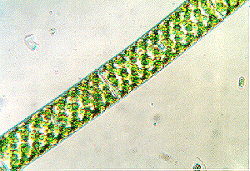 Looking through the various books and articles about
microscopy and pondering over the many beautiful photos of
protozoa etc., I thought to myself, "You must need very
expensive and sophisticated equipment to manage to produce such
wonderful shots". Being an amateur and collector of 'scopes
I don't have this type of gear at hand but I decided to give it a
try anyway.
Looking through the various books and articles about
microscopy and pondering over the many beautiful photos of
protozoa etc., I thought to myself, "You must need very
expensive and sophisticated equipment to manage to produce such
wonderful shots". Being an amateur and collector of 'scopes
I don't have this type of gear at hand but I decided to give it a
try anyway.
Image right shows a filamentous algae,
possibly Spirogyra.
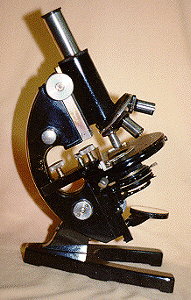 The scope I use most is a 1941 Zeiss listed as a 'scope
suitable for bacteriology (shown left). We must remember that
most of the research and discoveries made in the last century or
so were made using old 'scopes like this or even older so don't
go thinking you need an ultra-modern instrument.
The scope I use most is a 1941 Zeiss listed as a 'scope
suitable for bacteriology (shown left). We must remember that
most of the research and discoveries made in the last century or
so were made using old 'scopes like this or even older so don't
go thinking you need an ultra-modern instrument.
My camera is almost as old, an old Zenith SLR,
for which I managed to find a set of extension tubes. These when
screwed in the place of the camera lens make an excellent adapter
which doesn't actually have to fit neatly over the eye-piece
tube. I just hold the whole thing over the eye-piece and focus
then take my picture. The tubes give the exact distance so as to
fill the whole frame with the object and doesn't allow extraneous
light onto the film.
Image left below: a heliozoan protozoan (Actinosphaerium?).
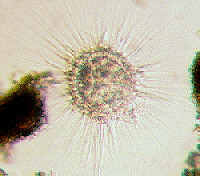
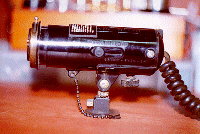 The first few photos were obviously pretty poor as I
was practising with my new setup, the biggest problem was enough
light. I picked up an old air-force signalling lamp which had a
focusing tube and a condenser (shown right). I fitted a square
filament microscope lamp to this and superglued a spare iris
diaphragm with filter carrier to the front. This supplied with a
6 volt 3 amp transformer is now converted into a half decent
Köhler illuminator.
The first few photos were obviously pretty poor as I
was practising with my new setup, the biggest problem was enough
light. I picked up an old air-force signalling lamp which had a
focusing tube and a condenser (shown right). I fitted a square
filament microscope lamp to this and superglued a spare iris
diaphragm with filter carrier to the front. This supplied with a
6 volt 3 amp transformer is now converted into a half decent
Köhler illuminator.
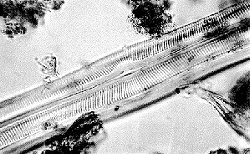 Through trial and error I managed to get most of my
pictures right but I still need more practice, but this is a
common factor of anything new one tries. So you see, you don't
need a huge heavy ultra modern lab. 'scope nor a very expensive
camera and adaptor to get half decent photos of your favourite
subjects. Try it and experiment with other bits and pieces you
may pick up. You'll amaze yourself, and believe me, you'll get a
lot of pleasure out of seeing your results. I know I did. With
low magnifications you shouldn't have any problems with light, a
good blue sky with white clouds should be sufficient, the real
problem starts with higher magnifications and oil-immersion
lenses.
Through trial and error I managed to get most of my
pictures right but I still need more practice, but this is a
common factor of anything new one tries. So you see, you don't
need a huge heavy ultra modern lab. 'scope nor a very expensive
camera and adaptor to get half decent photos of your favourite
subjects. Try it and experiment with other bits and pieces you
may pick up. You'll amaze yourself, and believe me, you'll get a
lot of pleasure out of seeing your results. I know I did. With
low magnifications you shouldn't have any problems with light, a
good blue sky with white clouds should be sufficient, the real
problem starts with higher magnifications and oil-immersion
lenses.
Image right above: a diatom showing the
markings on the silica frustule.
Image left below: Stentor, a protozoan.
Image right below: Vorticella, a protozoan with a contractile
stalk.
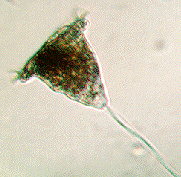
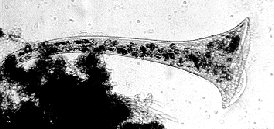 The illuminator I made up has shown itself worthy even
at higher mags. Some books suggest you remove the eye-piece. This
isn't really necessary at all, in fact I find leaving the
eye-piece in position gives better results. If you haven't got an
adaptor or extension tubes for your camera, try using even a
cardboard tube painted matt black inside, one that just fits a
little tightly in the place where the camera lens goes. Then
position this over the eye-piece so it just covers it, and try
your focusing skills. Some patience and a good eye are needed to
focus on the frosted glass screen of the camera but it can be
done. Good luck.
The illuminator I made up has shown itself worthy even
at higher mags. Some books suggest you remove the eye-piece. This
isn't really necessary at all, in fact I find leaving the
eye-piece in position gives better results. If you haven't got an
adaptor or extension tubes for your camera, try using even a
cardboard tube painted matt black inside, one that just fits a
little tightly in the place where the camera lens goes. Then
position this over the eye-piece so it just covers it, and try
your focusing skills. Some patience and a good eye are needed to
focus on the frosted glass screen of the camera but it can be
done. Good luck.
Roland
Mortimer
© Microscopy UK or their
contributors.
Please report any Web problems
or offer general comments to the Micscape Editor,
via the contact on current Micscape Index.
Micscape is the on-line monthly
magazine of the Microscopy UK web
site at Microscopy-UK
WIDTH=1
© Onview.net Ltd, Microscopy-UK, and all contributors 1995 onwards. All rights
reserved. Main site is at www.microscopy-uk.org.uk with full mirror at www.microscopy-uk.net.
 Looking through the various books and articles about
microscopy and pondering over the many beautiful photos of
protozoa etc., I thought to myself, "You must need very
expensive and sophisticated equipment to manage to produce such
wonderful shots". Being an amateur and collector of 'scopes
I don't have this type of gear at hand but I decided to give it a
try anyway.
Looking through the various books and articles about
microscopy and pondering over the many beautiful photos of
protozoa etc., I thought to myself, "You must need very
expensive and sophisticated equipment to manage to produce such
wonderful shots". Being an amateur and collector of 'scopes
I don't have this type of gear at hand but I decided to give it a
try anyway.  The scope I use most is a 1941 Zeiss listed as a 'scope
suitable for bacteriology (shown left). We must remember that
most of the research and discoveries made in the last century or
so were made using old 'scopes like this or even older so don't
go thinking you need an ultra-modern instrument.
The scope I use most is a 1941 Zeiss listed as a 'scope
suitable for bacteriology (shown left). We must remember that
most of the research and discoveries made in the last century or
so were made using old 'scopes like this or even older so don't
go thinking you need an ultra-modern instrument.
 The first few photos were obviously pretty poor as I
was practising with my new setup, the biggest problem was enough
light. I picked up an old air-force signalling lamp which had a
focusing tube and a condenser (shown right). I fitted a square
filament microscope lamp to this and superglued a spare iris
diaphragm with filter carrier to the front. This supplied with a
6 volt 3 amp transformer is now converted into a half decent
Köhler illuminator.
The first few photos were obviously pretty poor as I
was practising with my new setup, the biggest problem was enough
light. I picked up an old air-force signalling lamp which had a
focusing tube and a condenser (shown right). I fitted a square
filament microscope lamp to this and superglued a spare iris
diaphragm with filter carrier to the front. This supplied with a
6 volt 3 amp transformer is now converted into a half decent
Köhler illuminator. Through trial and error I managed to get most of my
pictures right but I still need more practice, but this is a
common factor of anything new one tries. So you see, you don't
need a huge heavy ultra modern lab. 'scope nor a very expensive
camera and adaptor to get half decent photos of your favourite
subjects. Try it and experiment with other bits and pieces you
may pick up. You'll amaze yourself, and believe me, you'll get a
lot of pleasure out of seeing your results. I know I did. With
low magnifications you shouldn't have any problems with light, a
good blue sky with white clouds should be sufficient, the real
problem starts with higher magnifications and oil-immersion
lenses.
Through trial and error I managed to get most of my
pictures right but I still need more practice, but this is a
common factor of anything new one tries. So you see, you don't
need a huge heavy ultra modern lab. 'scope nor a very expensive
camera and adaptor to get half decent photos of your favourite
subjects. Try it and experiment with other bits and pieces you
may pick up. You'll amaze yourself, and believe me, you'll get a
lot of pleasure out of seeing your results. I know I did. With
low magnifications you shouldn't have any problems with light, a
good blue sky with white clouds should be sufficient, the real
problem starts with higher magnifications and oil-immersion
lenses.
 The illuminator I made up has shown itself worthy even
at higher mags. Some books suggest you remove the eye-piece. This
isn't really necessary at all, in fact I find leaving the
eye-piece in position gives better results. If you haven't got an
adaptor or extension tubes for your camera, try using even a
cardboard tube painted matt black inside, one that just fits a
little tightly in the place where the camera lens goes. Then
position this over the eye-piece so it just covers it, and try
your focusing skills. Some patience and a good eye are needed to
focus on the frosted glass screen of the camera but it can be
done. Good luck.
The illuminator I made up has shown itself worthy even
at higher mags. Some books suggest you remove the eye-piece. This
isn't really necessary at all, in fact I find leaving the
eye-piece in position gives better results. If you haven't got an
adaptor or extension tubes for your camera, try using even a
cardboard tube painted matt black inside, one that just fits a
little tightly in the place where the camera lens goes. Then
position this over the eye-piece so it just covers it, and try
your focusing skills. Some patience and a good eye are needed to
focus on the frosted glass screen of the camera but it can be
done. Good luck.